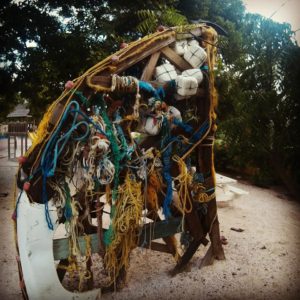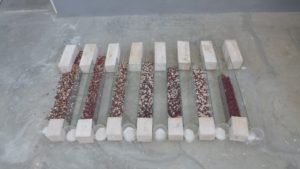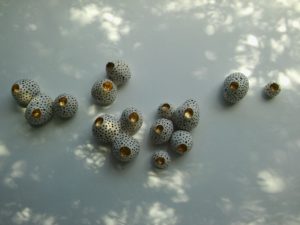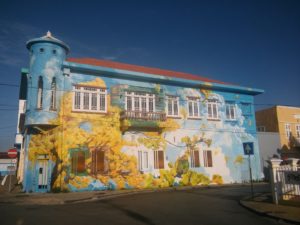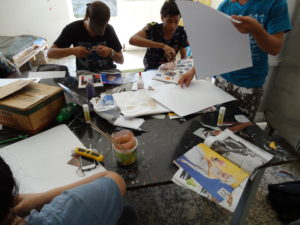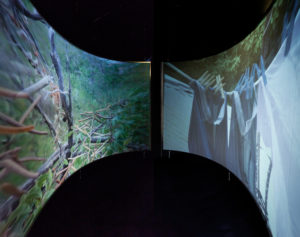
In November last year Sasha Dees started travelling in the Caribbean region, researching the sustainability of contemporary art practices and the influence of international (exchange) projects, funding, markets and politics. During her research she will be keeping a travelogue for Africanah. Her first stop in the region was Ayiti (Haiti), one of the islands in the region she has not spent any time before (see February edition). This time she reports from Korsou (Curacao).
Tony Capellán, Mar Caribe, 1996.
Caribbean Travelogue 2
Kòrsou
In November last year I started travelling in the Caribbean region, researching the sustainability of contemporary art practices and the influence of international (exchange) projects, funding, markets and politics. During my research I will be keeping a travelogue for Africanah. This past month I was in Kòrsou (Curaçao) an island I have visited several times over the past decades both for work and to visit friends. For those of you who follow me and my research in Trendbeheer (1) and/or on social media: yes, I was in Republica Dominicana (DR) after Ayiti (Haiti) before Kòrsou. My research in DR will be done in two parts, the article on DR will be out this summer after my second trip.
I enjoy diving much deeper and wider into the art scene in Kòrsou and mapping the infrastructure that artists have to work in as best I can. I meet and speak with people working in the arts in various disciplines, styles, genres, functions… Some people that I knew of or might have met in passing I now learn about their work, experience and visions more in-depth. A lot of the contemporary artists I already know and/or have worked with in the past. I’m happy to see they are working with their passion and urgency intact and that no matter the sometimes difficult circumstances continue to experiment, learn and grow in their work.
Roberto Tjon A Meeuw, Piská, 2017, (detail installation)
Kòrsou too, like all islands in the Caribbean Sea, has major problems with waste (2), especially plastic. Not only their own waste but waste that floats in from other countries and sea traffic which “lands” on the coast by the current. Roberto Tjon A Meeuw is as passionate about nature and the environment as he is about art. He does not let a moment pass by to provoke people to think when they encounter his artwork about the major environmental problems we have worldwide, like the plastic waste problem. He uses waste and recycled materials as his medium and makes large installations that lately, after his move to Kòrsou from Suriname where he mainly used recycled wood, sometime recall the work of Tony Capellan.
Ailsa Anastatia, Unity, (2016)
Ailsa Anastatia is fascinated by space, both in a literal and in a spiritual way. Her work is guided by the material she works with–she likes to experiment with different materials and their possibilities. Her color palette is subdued and the aesthetic is abstract, simple and minimalistic, contradicting all our assumptions, bright colors, figurative, when we think of the Caribbean. When I first met Anastatia she painted exclusively but in the course of her career the paintings have come off the wall, hesitantly but persistent. In recent years she is making installations along with her paintings and this year she is experimenting with video.
Given its population of 160,000, the art scene is relatively big. There are a few local galleries–Alma Blou and Landhuis Bloemhof being the consistent ones; art consultants Marlies Schoenmaker and Verele Gehring Engels; institutes like Curacao Museum, Kas di Kultura, Prins Bernhard Cultuur Fonds Caribisch gebied, and new kid on the block, UniArte, an incubator space for contemporary art; cultural curators Jennifer Smit and Jossee Rojer Thiessen; cultural producers Lysaye de Windt and Marlon Reina; and professional contemporary artists notably Ailsa Anastatia, Avantia Damberg, Ellen Spijkstra, Roberto Tjon A Meeuw, Sharelly Emanuelson and Tirzo Martha.
Ellen Spijkstra, Tunicate Buds.
Ellen Spijkstra started as a ceramist. She is one of four members of the Academy of International Ceramists in the region, and later in her career also developed a photography practice. At the moment, her photo work represents Kòrsou in the much acclaimed group exhibition Relational Undercurrents in MOLAA in Los Angeles (3). Over the four decades of her career she has steadily built and maintained a fabulous studio space that by now has various size ovens and a little guesthouse. Bound to the island as her children were growing up, she would invite international colleagues to work, give workshops and vacation. This resulted in a growing interest for ceramics on the island and for Spijkstra it meant she could maintain her professional network and continue to be part of the critical international discourse. Now that her children are grown she regularly accepts invitations to residencies and conferences herself. In a world of artworks reflecting political and social issues Spijkstra’s work is abstract. Her fascination is with beauty and (like Anastatia) in material and form. Even when being confronted with an ugly truth and/or visual, Spijkstra then searches till she finds the abstract simple beauty that can be found everywhere in anything.
Invisible at first glance but fascinating to notice after more and more conversations is the explosion of talent development and social design (the process that contributes to improving human well-being and bringing about social and behavioral change). Social design came up fast in the eighties and over the past 40 years has been adapted in many governmental and foundation policies worldwide. Arts and talent development are often used as tools for social design as they are by many organizations on this island. Art Foundation Curacao producer of Plein Air Curacao works during the year with children and youth in different neighborhoods in after-school programs and community centers. A handful of pre-education organizations give workshops to locals and groom youth and help them build a presentable portfolio to go to art academies abroad for bachelor programs. Media School (film and media), Academy for Arts and Science (painting) and IBB (mixed media) for example, were founded to jump into the gap that was created when the government cancelled their pre-education Public Art Academy in 2002.
Francis Sling, Three O’clock Romance, 2017
Driving through the city you immediately notice the abundance of street art. Some of it looks awesome and is definitely enhancing the surroundings. Some is a hot mess. Artists like Garrick Marchena and Francis & Omar Sling became professional muralists that can live off this work. Walls, fences and huge monumental buildings are completely being painted, commissioned by the owners or by organizations that work with youth. There are murals everywhere and specifically in areas that are being gentrified or working class districts. Artist Avantia Damberg cleverly jumped on this and organizes Art Tours in different areas on the island including areas tourists normally would avoid or are not advised to explore.
There is an extreme focus on projects for youth. All of the above mentioned organizations including the just opened (2 months) Children’s Museum and small project agencies like Concept Company (co-founder of Curacao Cares) link and use art with and for social design projects. Independent artists like Roberto Tjon a Meeuw and muralist Garrick Marchena are hired on a frequent basis to do large social projects often with youth. IBB students are asked to work and realize projects with the patients of the psychiatric complex where their studios are located, community centers and collaborate with the Children Museum working with children making art works.
IBB Workshop Fasion, September 2015.
Everybody keeps talking about children not being exposed to art but I sincerely wonder if there is a child on the island that has not been confronted with art at some point, I’m amazed by its scale and applaud it. The problem seems it remains to be just that, the art field does its part and does it well but the social art projects regretfully happen randomly and in a vacuum with no real structural engagement. Art, like philosophy, science and sports should be part of the school curriculum for all education until high school. But nowadays art and talent development are cleverly being used (not limited to Kòrsou) by governments advocating and supporting social design projects to cover up the steep and rapid declining free public educational systems where more and more subjects and learning areas get cut and thrown out of the curriculum. At this time there’s only 4 hours schooldays in Kòrsou, on top of the decreased quality criteria and standards for curriculum, teachers and leadership (also not limited to Kòrsou).
Art at best will provoke people to think about something, whether existential, sociopolitical or merely beauty and aesthetics. An art work however can’t enhance the first basic needs for human wellbeing. Good quality free public education for all will do that. Realistic minimum wages so everybody at least can feed their children pay their rent, water and electricity will do that. That nicely painted wall or sculpture artists make with children or youth, might make us feel good about ourselves, but in a neighborhood where children leave for school without breakfast, have no running water or limited electricity, it is not enhancing the well-being of anybody living there. Let’s not get it twisted, as people working in the arts, governments and foundations funding these projects, while our basic needs for well-being are totally covered, it is enhancing our well-being only. Art works have and will never provide the basic needs for human wellbeing and neither should it be expected to do so. It made me start realizing that it actually makes us in the art field complicit in letting governments get away with not taking responsibility and not fulfilling their obligation to its society and all people living in it.
Another problem with talent development specifically arises as we pour resources, time and energy into bringing water to the ocean… We can develop all the talent in the world but if we don’t invest in a widespread infrastructure, supported by a variety of independent organizations and people guaranteeing critical discourse and reflection within that including good transparent cultural governance, then really what’s the point?
Sharelly Emanuelson, Siudadanos, 2015, (SMBA, Amsterdam)
Don’t get me wrong I am all for developing talent because there is an urgency for that and it should continue. But like in any other field, it is important to invest in the chain not just into one or two or even three links. All links that make a chain need to be invested in and nurtured at the same time. If that means less talent developing, pick the talented ones who show real artistic urgency and ambition for the arts and nurture those and make sure they also have an infrastructure to grow in. A maximum 500 Naf (200$) subsidy given by the government through Kas di Kultura for projects clearly is not doing that and frankly to me feels disrespectful to any artist or artisan working in Kòrsou.
All fields, whether education, tourism, agriculture, healthcare or the arts, need an overarching vision and policy for how to maintain the chain and if the circumstances allow it, to grow the chain stronger or bring it back to its core if times call for cutbacks. It is the chain that needs to be protected by its field, governments and by the society at large. We need to be loud and clear about what the function and value of the art field is to its society and constantly keep the society and governments aware of that function and value.
I sincerely hope everybody agrees that the function and value of the arts is not and should not be a band aid or cover up for declining education, a growing population living below the poverty line, rise of criminality and badly functioning governments in flawed democracies no longer taking care of all its people (all applicable but not limited to Kòrsou!).
BACKGROUND TIMELINE KòRSOU (4)
Kòrsou, BC was populated by Arawak people trekking around in the region.
450AD: Caquetio (a specific Arawak people) settled down permanently on the island, settlements from that period were found in Kenepa and Santa Barbara. Caquetio are considered the autochthonous population that named the island Kòrsou.
1499: Kòrsou, was invaded by the Spanish led by Alonso de Ojeda (although he personally never set foot on the island). The Spanish didn’t do much with the island, it was controlled by the governor of Santo Domingo.
Mid-17th century: The Dutch West India Company (WIC) invaded the island and conquered it from the Spanish invaders. It was documented that at that time 400 indigenous Caquetio people lived on the island. The Dutch wanted the island because they needed salt to conserve their food. They ended up making the island profitable by using it as their central market in the Trans-Atlantic human slave trade for the region. They kept the “unsaleable commodity” to work on WIC plantations on the island. During 1600 – 1850, the Dutch traded 550.000 enslaved people from Africa and 86.000 came through Kòrsou (5).
1795: A major revolt by enslaved people took place at Kenepa led by Tula Rigaud, Louis Mercier, Bastian Karpata, and Pedro Wakao. After over a month the revolt was suppressed and Tula was executed.
July 1, 1863: Emancipation, for the then 6.684 enslaved on the island.
1863 – 1918: After emancipation, the island’s legal economy was based on agriculture and its natural harbor. Smuggling of rum and weapons is how the WIC made their fortune at this time. The WIC and/or colonial authorities signing off official paperwork showing “Open Sea” as its destination (6). Majestic mansions were built at home as well in the region, evidence to date can be found for example in the district Scharloo.
1914: Royal Shell Group started building a refinery on Kòrsou, after oil was found in Venezuela earlier that century, given their natural harbor and its proximity to Venezuela. It could also be used as a bunker harbor on route to the Panama Channel. It changed the economy of the island entirely.
1940: The Dutch implemented a new law “De Wet Vrijwillige Zetelverplaatsing” (Company Seat Relocation Act). Just before Nederland and Nederland’s Indie (Indonesia) were occupied during WOII. Large Dutch companies like Shell, KLM, HAL, Unilever and Philips relocated their company seats pro forma to Kòrsou. They requested taxes to be lowered. Notary Mr. A.A.G. Smeets proposed a 2, 4 – 3% profit tax which was agreed upon in Dutch parliament. It included tax agreements between Kòrsou and the European countries (and after WWII with the USA), making Smeets the architect of offshore and offshore the main income to Kòrsou after oil (7).
1954: A new constitution for the Kingdom of the Netherlands was signed (Het Statuut) in which Aruba, Bonaire, Kòrsou, Saba, St. Eustatius and St. Maarten officially became Nederlandse Antillen an autonomous territory in the Kingdom of the Netherlands its government was seated in Kòrsou.
May 30, 1969: Trinta di mei, a major workers uprising (8) grew out of a strike of the local contractors of Royal Dutch Shell who demanded “Pan I Rekonosementu (bread and acknowledgement). Trinta di mei devastated the island (damages were an estimated 50 million US$) but the turning point to major changes towards equality in education, labor pay & laws and access to the management positions for all “yi di Kòrsou” (all people from Kòrsou regardless of race and color).
2010: Kòrsou became an autonomous country within the Kingdom of the Netherlands with the Kingdom retaining responsibility for defense and foreign policy. It has a unitary parliamentary representative democracy under constitutional monarchy, its Minister President is Eugene Rhuggenaath (PAR).
The island size is 171.4 mi² and has a population of 160.337 people, an Afro-Caribbean majority; Dutch, French, Latin American, East Asian, South Asian and Jewish minorities (no statistics available); its main religion is Catholic (72%) (9). GPD per capita is $15.000 (10). The official language Papiamentu can be found in official documents as of the 18th century.
Kòrsou was the main publisher for sheet music and one of the bigger publishers of literature for Latin America and the Caribbean region in the 19th Century. Visual Arts is recent to the field (20th Century), Chris Engels & Lucila Engels Boskaljon being two of the pioneers and co-founders of the Curaçao Museum. Lucila was the first artist from Kòrsou to participate in an international biennale (Sao Paolo, 1955). The exhibition 70 Years Curaçao Museum opens March 10, 2018 curated by his daughter Verele Gehring Engels and Julie Hengeveld including a catalogue 70 Years Curacao Museum (LM Publishers).

